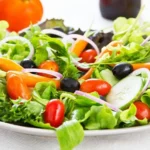
A hen requires 24 to 26 hours to produce an egg.
30 minutes later, she starts all over again.
The eggshell may have as many as 17,000 tiny pores over its surface. Through them, the egg can absorb flavours and odours.
Eggs age more in one day at room temperature than in one week in the refrigerator.
Hens with white feathers and ear lobes produce white shelled eggs. Hens with red or brown feathers and red ear lobes produce brown shelled eggs.
Most eggs are laid between 7-11 AM
A hen requires 24 to 26 hours to produce an egg. Thirty minutes later, she starts all over again.
The difference between brown and white-shelled eggs is the breed of hen. Breeds with white earlobes (and feathers) lay white eggs; breeds with red earlobes (and brown feathers) lay brown eggs. Both white and brown eggs have the same nutritional qualities.
As a hen ages, her eggs increase in size. Small eggs come from young hens, while jumbo eggs are laid by older hens.
Occasionally, a hen will produce double-yolked eggs. It is rare, but not unusual, for a young hen to produce an egg with no yolk at all.
The little white ropey strands in an egg white are called “chalaza”. Their function is to anchor the yolk in the center of the egg. They are neither imperfections nor beginning embryos, and are completely safe to eat. In fact, the more prominent the chalazae, the fresher the egg!
Nobody really knows when the first fowl was domesticated, although Indian history places the date as early as 3200 B.C. Egyptian and Chinese records show that fowl were laying eggs for man in 1400 B.C. It is believed that Columbus’ ships carried the first of the chickens related to those now in egg production to this country.
Yolk color depends on the diet of the hen. Natural yellow-orange substances such as marigold petals may be added to light-colored feeds to enhance colors. Artificial color additives are not permitted.
To tell if an egg is raw or hard-cooked, spin it! If the egg spins easily, it is hard-cooked but if it wobbles, it is raw.
If an egg is accidentally dropped on the floor, sprinkle it heavily with salt for easy clean up.
Egg yolks are one of the few foods that naturally contain Vitamin D.
Yolk colour depends on the diet of the hen. Natural yellow-orange substances such as marigold petals may be added to light-colored feeds to enhance colours. Artificial colour additives are not permitted.
Eggs are nutritious for many pets as well as humans and are often an important part of prepared pet food formulas. Eggs can improve animal fur and coat health and maintain eyesight.
A pullet is a ‘young’ hen (like a heifer is a ‘young’ cow)
The egg shell accounts for about 9 to l2% of its total weight.
The shell is largely composed of calcium carbonate (about 94%) with small amounts of magnesium carbonate, calcium phosphate and other organic matter including protein. Shell strength is greatly influenced by the minerals and vitamins in the hen’s diet, particularly calcium, phosphorus, manganese and Vitamin D. If the diet is deficient in calcium, for instance, the hen will produce a thin or soft-shelled egg or possibly an egg with no shell at all.
Shell thickness is also related to egg size, which, in turn, is related to the hen’s age. As the hen ages, egg size increases. The same amount of shell material which covers a smaller egg must be ‘stretched’ to cover a larger one, hence the shell is thinner.
Eggs are an important source of complete protein for vegetarians. One egg = 1 ounce of lean meat, fish or poultry.
Egg Nutritional Facts:
Eggs are a nutritional powerhouse packed with a surprising amount of essential vitamins, minerals, and protein for a relatively low number of calories. Here’s a breakdown of the key nutrients found in a large egg (around 50 grams):
Calories: One large egg contains about 72 calories, making them a great option for a filling and nutritious breakfast or snack without breaking the calorie bank.
Protein: Eggs are a complete protein source, meaning they contain all nine essential amino acids your body needs to build and repair tissues. A large egg boasts around 6 grams of high-quality protein.
Fat: Don’t fear the fat! Eggs contain around 5 grams of fat per serving, with most of it being unsaturated fat, including beneficial monounsaturated fats. These fats can actually help lower your LDL (“bad”) cholesterol levels and raise HDL (“good”) cholesterol.
Carbohydrates: Eggs are very low in carbohydrates, containing less than 1 gram per serving. They are also virtually sugar-free, making them a suitable choice for low-carb diets.
Vitamins and Minerals: Eggs are a treasure trove of essential vitamins and minerals, including:
Choline: This vital nutrient supports brain health, memory, and cell signaling. (31% of Daily Value – DV)
Vitamin B12: Essential for red blood cell formation and nervous system function. (21% of DV)
Vitamin D: Important for bone health and immune function. (6% of DV)
Riboflavin (Vitamin B2): Plays a role in energy production and cell function. (15% of DV)
Selenium: An antioxidant mineral that protects cells from damage. (28% of DV)
Iron: Crucial for oxygen transport in the blood. (5% of DV)
Phosphorus: Important for bone health and energy production. (9% of DV)
Additional Benefits:
Eye health: Eggs contain lutein and zeaxanthin, carotenoids that may help protect your eyes from age-related macular degeneration and cataracts.
Mood and Memory: Choline, found abundantly in eggs, plays a role in brain development, memory function, and mood regulation.
Weight Management: The protein and healthy fats in eggs can keep you feeling fuller for longer, potentially aiding in weight management efforts.
Remember: While generally safe for most people, some individuals might have egg allergies. If you experience any adverse reactions after consuming eggs, consult a healthcare professional.








